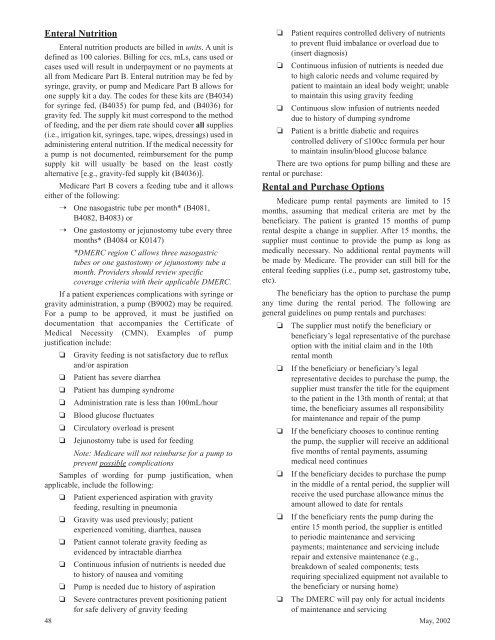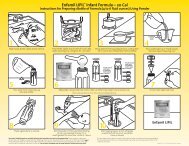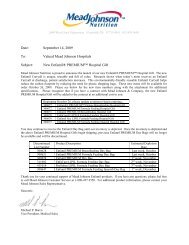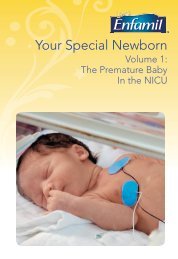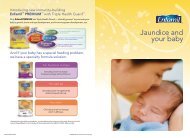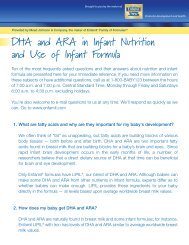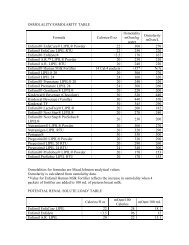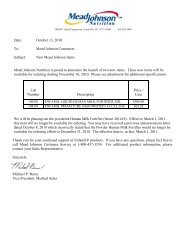You also want an ePaper? Increase the reach of your titles
YUMPU automatically turns print PDFs into web optimized ePapers that Google loves.
Enteral <strong>Nutrition</strong>Enteral nutrition products are billed in units. A unit isdefined as 100 calories. Billing for ccs, mLs, cans used orcases used will result in underpayment or no payments atall from Medicare Part B. Enteral nutrition may be fed <strong>by</strong>syringe, gravity, or pump and Medicare Part B allows forone supply kit a day. The codes for these kits are (B4034)for syringe fed, (B4035) for pump fed, and (B4036) forgravity fed. The supply kit must correspond to the methodof feeding, and the per diem rate should cover all supplies(i.e., irrigation kit, syringes, tape, wipes, dressings) used inadministering enteral nutrition. If the medical necessity fora pump is not documented, reimbursement for the pumpsupply kit will usually be based on the least costlyalternative [e.g., gravity-fed supply kit (B4036)].Medicare Part B covers a feeding tube and it allowseither of the following:48➝One nasogastric tube per month* (B4081,B4082, B4083) or➝ One gastostomy or jejunostomy tube every threemonths* (B4084 or K0147)*DMERC region C allows three nasogastrictubes or one gastostomy or jejunostomy tube amonth. Providers should review specificcoverage criteria with their applicable DMERC.If a patient experiences complications with syringe orgravity administration, a pump (B9002) may be required.For a pump to be approved, it must be justified ondocumentation that accompanies the Certificate ofMedical Necessity (CMN). Examples of pumpjustification include:❏❏❏❏❏❏❏Gravity feeding is not satisfactory due to refluxand/or aspirationPatient has severe diarrheaPatient has dumping syndromeAdministration rate is less than 100mL/hourBlood glucose fluctuatesCirculatory overload is presentJejunostomy tube is used for feedingNote: Medicare will not reimburse for a pump toprevent possible complicationsSamples of wording for pump justification, whenapplicable, include the following:❏❏❏❏❏❏Patient experienced aspiration with gravityfeeding, resulting in pneumoniaGravity was used previously; patientexperienced vomiting, diarrhea, nauseaPatient cannot tolerate gravity feeding asevidenced <strong>by</strong> intractable diarrheaContinuous infusion of nutrients is needed dueto history of nausea and vomitingPump is needed due to history of aspirationSevere contractures prevent positioning patientfor safe delivery of gravity feeding❏❏❏Patient requires controlled delivery of nutrientsto prevent fluid imbalance or overload due to(insert diagnosis)Continuous infusion of nutrients is needed dueto high caloric needs and volume required <strong>by</strong>patient to maintain an ideal body weight; unableto maintain this using gravity feedingContinuous slow infusion of nutrients neededdue to history of dumping syndrome❏ Patient is a brittle diabetic and requirescontrolled delivery of ≤100cc formula per hourto maintain insulin/blood glucose balanceThere are two options for pump billing and these arerental or purchase:Rental and Purchase OptionsMedicare pump rental payments are limited to 15months, assuming that medical criteria are met <strong>by</strong> thebeneficiary. The patient is granted 15 months of pumprental despite a change in supplier. After 15 months, thesupplier must continue to provide the pump as long asmedically necessary. No additional rental payments willbe made <strong>by</strong> Medicare. The provider can still bill for theenteral feeding supplies (i.e., pump set, gastrostomy tube,etc).The beneficiary has the option to purchase the pumpany time during the rental period. The following aregeneral guidelines on pump rentals and purchases:❏❏❏❏❏❏The supplier must notify the beneficiary orbeneficiary’s legal representative of the purchaseoption with the initial claim and in the 10thrental monthIf the beneficiary or beneficiary’s legalrepresentative decides to purchase the pump, thesupplier must transfer the title for the equipmentto the patient in the 13th month of rental; at thattime, the beneficiary assumes all responsibilityfor maintenance and repair of the pumpIf the beneficiary chooses to continue rentingthe pump, the supplier will receive an additionalfive months of rental payments, assumingmedical need continuesIf the beneficiary decides to purchase the pumpin the middle of a rental period, the supplier willreceive the used purchase allowance minus theamount allowed to date for rentalsIf the beneficiary rents the pump during theentire 15 month period, the supplier is entitledto periodic maintenance and servicingpayments; maintenance and servicing includerepair and extensive maintenance (e.g.,breakdown of sealed components; testsrequiring specialized equipment not available tothe beneficiary or nursing home)The DMERC will pay only for actual incidentsof maintenance and servicingMay, 2002


